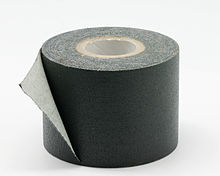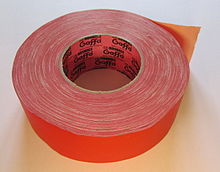

Gaffer tape (also known as gaffer's tape, gaff tape or gaffa tape as well as spike tape for narrow, colored gaffer tape) is a heavy cotton cloth pressure-sensitive tape with strong adhesive and tensile properties. It is widely used in theatre, photography, film, radio and television production, and industrial staging work.
While sometimes confused with duct tape, gaffer tape differs in the composition of both the backing, which is made from fabric as opposed to vinyl or other plastics, and the adhesive, which is more resistant to heat and more easily removed without damaging the surface to which it adhered.
History
The precise origin of the name is unknown, one hypothesis being that it is named for the gaffer (chief lighting technician) on a film crew. When cables are taped down on a stage or other surface, either to prevent tripping hazards or conceal them from view of the audience or camera, they are said to be gaffed or gaffered.
Gaffer tape was invented in 1959 by Ross Lowell, director, cinematographer, and founder of Lowel-Light. Lowell reworked Johnson & Johnson's Permacel duct tape product by combining the Permacel adhesive with a silver fabric backing to create gaffer tape which could hold a flat metal plate to a window.
Properties and uses

Gaffer tape is manufactured in many colors, including fluorescent and custom colors, but perhaps the most common variety is matte black. A matte finish keeps the tape from reflecting light, so that it blends in with a typical stage floor. It is sold in a variety of widths, from 1⁄4 in (6 mm) to 4 in (102 mm), with 1 in (25 mm) and 2 in (51 mm) being the most common. Gaffer tape is strong, yet can be torn by hand, so no cutting tools are necessary, and it can easily be ripped into narrower strips when desired. The synthetic adhesive typically leaves little or no residue and will generally not damage most surfaces when it is removed. Gaffer tape is usually more expensive than duct tape because it is manufactured in smaller quantities, has more exacting specifications, and is marketed for professional use.

A common application for gaffer tape is securing cables to a stage floor, podium, or other surface, either for safety or concealment. It is also frequently used whenever a quick ad hoc fix is required, from temporarily attaching fixtures or props, to salvaging a broken piece of production equipment. A narrow version of gaffer tape, called spike tape, is used in theater productions for floor layout.
In the absence of console tape or artist tape, live sound engineers or light board operators may use a strip of white gaffer tape along the bottom of a mixing board to label the channels or submasters used for a particular show.
In rock climbing gyms, gaffer tape can be used to mark climbs on the wall. It is preferable to duct tape because it is stronger and lasts longer on the wall.
See also
References
- Lawler, Mike (2007), Careers in Technical Theater, Allworth Communications, Inc., p. 97, ISBN 9781581154856
- Lehman, J. (2005). "Sticking With What Works". EventDV. 18 (12): 23. ISSN 1554-2009.
- ^ "What is Gaffer's Tape?". wiseGEEK. Retrieved 22 February 2015.
- Church of the Holy Gaffer Tape - Top Tips for Gaffer Tape, archived from the original on 2007-11-12, retrieved 2007-10-29
- "Gaffing cable to the floor". ControlBooth. Retrieved 2016-03-09.
- "About Lowel Light". lowel.tiffen.com. Archived from the original on 2019-02-26. Retrieved 2019-12-02.
- "Obituary: Ross Lowell, Founder of Lowel-Light and Creator of Gaffer Tape, 92". PDNPulse. 2019-02-20. Archived from the original on 2019-02-26. Retrieved 2019-02-21.
- British Standards Document BS EN 12034—Self-adhesive tapes. Measurement of the length of a roll of adhesive tape, BSI Group, doi:10.3403/00971263u
- Mitsui, Toshiyuki; Satoh, Hiroyasu; Hida, Minemasa (2002). "Comparative Study of a Cluster Analysis and a Principal-Component Analysis Using a Polarized Imaging Technique for Discriminating Adhesive Cloth Tapes". Analytical Sciences. 18 (6): 717–22. doi:10.2116/analsci.18.717. ISSN 0910-6340. PMID 12083565.
- Johnson, Kevin (March 2009). "What's In Your Bag". Broadcast Engineering. 51 (3): 26–31. ISSN 0007-1994.
- Uva, Michael (2014). The Grip Book. Focal Press. ISBN 9780415842372. OCLC 879632388.
- "Types Of Tape (And Not The Recording Type) For Audio/Production". www.prosoundweb.com. Archived from the original on 23 February 2015. Retrieved 23 February 2015.